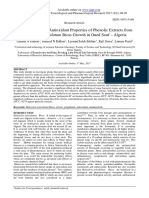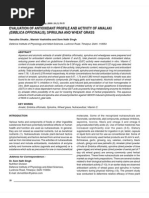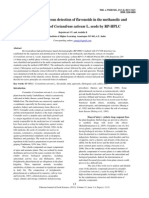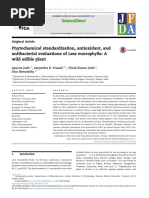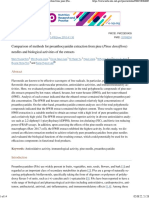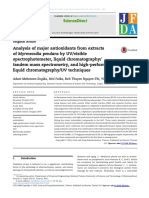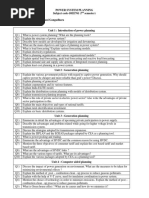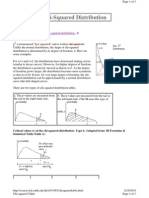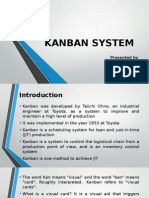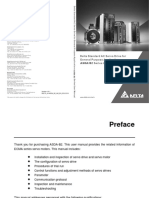0 ratings0% found this document useful (0 votes)
70 viewsPhenolic Composition and Antioxidant Properties of Some Traditionally Used Medicinal Plants Affected by The Extraction Time and Hydrolysis
Phenolic Composition and Antioxidant Properties of Some Traditionally Used Medicinal Plants Affected by The Extraction Time and Hydrolysis
Uploaded by
Beatriz MelloPolyphenolic phytochemicals in medicinal plants act as powerful antioxidants. Extracts of blackberry leaves were characterized with the highest content of phenolic compounds, as well as the highest antioxidant capacity.
Copyright:
© All Rights Reserved
Available Formats
Download as PDF, TXT or read online from Scribd
Phenolic Composition and Antioxidant Properties of Some Traditionally Used Medicinal Plants Affected by The Extraction Time and Hydrolysis
Phenolic Composition and Antioxidant Properties of Some Traditionally Used Medicinal Plants Affected by The Extraction Time and Hydrolysis
Uploaded by
Beatriz Mello0 ratings0% found this document useful (0 votes)
70 views9 pagesPolyphenolic phytochemicals in medicinal plants act as powerful antioxidants. Extracts of blackberry leaves were characterized with the highest content of phenolic compounds, as well as the highest antioxidant capacity.
Original Title
phytochem_1
Copyright
© © All Rights Reserved
Available Formats
PDF, TXT or read online from Scribd
Share this document
Did you find this document useful?
Is this content inappropriate?
Polyphenolic phytochemicals in medicinal plants act as powerful antioxidants. Extracts of blackberry leaves were characterized with the highest content of phenolic compounds, as well as the highest antioxidant capacity.
Copyright:
© All Rights Reserved
Available Formats
Download as PDF, TXT or read online from Scribd
Download as pdf or txt
0 ratings0% found this document useful (0 votes)
70 views9 pagesPhenolic Composition and Antioxidant Properties of Some Traditionally Used Medicinal Plants Affected by The Extraction Time and Hydrolysis
Phenolic Composition and Antioxidant Properties of Some Traditionally Used Medicinal Plants Affected by The Extraction Time and Hydrolysis
Uploaded by
Beatriz MelloPolyphenolic phytochemicals in medicinal plants act as powerful antioxidants. Extracts of blackberry leaves were characterized with the highest content of phenolic compounds, as well as the highest antioxidant capacity.
Copyright:
© All Rights Reserved
Available Formats
Download as PDF, TXT or read online from Scribd
Download as pdf or txt
You are on page 1of 9
Phenolic Composition and Antioxidant
Properties of Some Traditionally Used
Medicinal Plants Aected by the Extraction
Time and Hydrolysis
Draenka Komes,
a
* Ana Belak-Cvitanovi,
a
Dunja Hori,
a
Gordana Rusak,
b
Saa Liki
b
and Marija Berendika
a
ABSTRACT:
Introduction Polyphenolic phytochemicals intraditionally usedmedicinal plants act as powerful antioxidants, whicharoused
an increasing interest in their application in functional food development.
Objective The eect of extraction time (5 and 15 min) and hydrolysis on the qualitative and quantitative content of phenolic
compounds and antioxidant capacity of six traditionally used medicinal plants (Melissa ocinalis L., Thymus serpyllum L.,
Lavandula ocinalis Miller, Rubus fruticosus L., Urtica dioica L., and Olea europea L.) were investigated.
Methodology The content of total phenols, avonoids, avan-3-ols and tannins was determined using UV/Vis spectropho-
tometric methods, while individual phenolic acids, avones and avonols were separated and detected using HPLC analysis.
Also, to obtain relevant data on the antioxidant capacity, two dierent assays, (2,2-azino-bis(3-ethylbenzthiazoline-6-
sulphonic acid) (ABTS) radical scavenging and ferric reducing/antioxidant power (FRAP) assays were used.
Results The extraction eciency of phenolics, as well as the antioxidant capacity of plant extracts, was aected by both
prolonged extraction and hydrolysis. The overall highest content of phenolic compounds was determined in hydrolyzed
extract of blackberry leaves (2160 mg GAE/L), followed by the non-hydrolyzed extract of lemon balmobtained after 15 min of
extraction (929.33 mg GAE/L). The above extracts also exhibitedthe highest antioxidant capacity, while extracts of olive leaves
were characterized with the lowest content of phenolic compounds, as well as the lowest antioxidant capacity. The highest
content of rosmarinic acid, as the most abundant phenolic compound, was determined in non-hydrolyzed extract of lemon
balm, obtained after 15 min of extraction. Although the hydrolysis provided the highest content of polyphenolic compounds,
longer extraction time (15 min) was more ecient to extract these bioactives than shorter extraction duration (5 min).
Conclusion The distribution of detected phenolic compounds showed a wide variability with regard to their botanical origin.
Examined medicinal plants showed to be a valuable supplement to a daily intake of bioactive compounds. Copyright 2010
John Wiley & Sons, Ltd.
Keywords: antioxidant capacity; hydrolysis; medicinal plants; polyphenols; principal component analysia
Introduction
Medicinal plants commonly consumed worldwide contain dier-
ent chemical substances that display a broad spectrum of bio-
logical activities, enabling the induction of positive eects in
treatment of many human diseases.
The use of plant extracts as functional ingredients in various
food, beverage and cosmetic applications is gaining growing
interest among scientists, as well as among consumers and food
manufacturers. In the last few decades, numerous screening
studies of various plant materials have been performed in order
to nd naturally occurring antioxidants for use in food or medici-
nal preparations, as replacements for potentially harmful syn-
thetic additives (Reische et al., 1998). The dominant majority of
biologically active plant compounds with antioxidative proper-
ties are avonoids and other phenolics. These low molecular
weight secondary plant metabolites exhibit excellent antioxidant
properties. However, their particular mechanisms of action vary
depending both on the structure and environment. Besides phe-
nolic compounds, medicinal plants are reported to contain other
natural antioxidants such as vitamins (A, B
6
, C, E) and some other
phytochemicals like co-enzyme ubiquinone (Q
10
), carotenoids,
selenium and zinc (Atoui et al., 2005).
Medicinal plants have been extensively studied for the pres-
ence of natural antioxidants but the most emphasis has been
given to essential oils or to hexane, acetone, ethanol (or metha-
nol) and carbon dioxide extracts (Lagouri et al., 1993; Schwarz
et al., 1996; Tena et al., 1997; Dapkevicius et al., 1998). Since tea
and herbal infusions are generally prepared by steeping the
leaves and herbal parts in hot water, a more comprehensive and
thorough survey of the composition of water herbal extracts is
* Corresponding to: Prof. Dr. Draenka Komes, Department of Food Engineer-
ing, Faculty of Food Technology and Biotechnology, University of Zagreb,
Pierrotijeva 6, 10 000 Zagreb, Croatia. E-mail: dkomes@pbf.hr Phone +385 1
4826 250 Fax +385 1 4826 25
a
Faculty of FoodTechnology and Biotechnology, University of Zagreb, Pierot-
tijeva 6, 10000 Zagreb, Croatia
b
Department of Biology, Faculty of Science, University of Zagreb, Roosevel-
tov trg 6, 10 000 Zagreb, Croatia
Research Article
Received: 8 February 2010; Revised: 15 June 2010; Accepted: 17 June 2010 Published online in Wiley Online Library
(wileyonlinelibrary.com) DOI 10.1002/pca.1264
1
Phytochem. Anal. 2010 Copyright 2010 John Wiley & Sons, Ltd.
necessary. Due to the dierences in extraction and analysis
methods used (Rusak et al., 2008), the data regarding the phe-
nolic content of dierent plants is dicult to compare. Only with
the exact knowledge of the bioactive composition of medicinal
and other plants, it will be possible to develop a new generation
of standardized, eect-optimized mono- and multi-extract
preparations, which full todays standards for quality, safety and
eciency of medicinal drugs (Wagner and Ulrich-Merzenich,
2009).
In our study the analyses of total phenolics and specic groups
of phenolics (avonoids, avan-3-ols and tannins) of non-
hydrolyzed and hydrolyzed extracts of six medicinal plants tradi-
tionally used in Croatia (Melissa ocinalis L., Thymus serpyllum L.,
Lavandula ocinalis Miller, Rubus fruticosus L., Urtica dioica L., and
Olea europea L.) were carried out. Since natural antioxidants can
exert their eect through a variety of dierent mechanisms, it is
important to prove their antioxidative activities by dierent
assays. Therefore, as part of the ongoing antioxidant research on
plants, extracts were screened for their antioxidant properties
using an array of in vitro assays. Furthermore, qualitative and
quantitative analyses of phenolics in these extracts were carried
out using high performance liquid chromatography (HPLC).
Experimental
Chemicals
Analytical grade of Folin-Ciocalteu, formic acid, potassium peroxo-
disulfate, sodium carbonate, formaldehyde, ferric chloride hexa-
hydrate, ferrous sulphate heptahydrate and hydrochloric
acid were supplied by Kemika (Zagreb, Croatia). Methanol
(HPLC grade) was supplied by J.T.Baker (Deventer, Netherlands).
Vanillin, p-dimethylamminocinnamaldehyde, Trolox (6-hydroxy-
2,5,7,8-tetramethylchromane-2-carboxylic acid), ABTS (2,2-azino-bis(3-
ethylbenzthiazoline-6-sulphonic acid) diammonium salt) as well as
caeic acid (CA), ferulic acid (FA), p-coumaric acid (pCoumA), trans-
cinnamic acid (t-CA), rosmarinic acid (RA) and chlorogenic acid (ChlA)
were supplied by Sigma-Aldrich (Steinheim, Germany). Quercetin,
isorhamnetin, kaempferol, luteolin and myricetin were purchased from
Fluka (Switzerland).
Preparation of non-hydrolyzed plant extracts
Dried plant materials of lemon balm (Melissae folium), thyme (Serpylli
herba), lavender (Lavandulae os), blackberry (Rubi fructicosi folium), olive
(Oleae folium) and nettle (Urticae folium), were purchased from local
medicinal plant manufacture. In order to represent daily intake of bioac-
tive compounds, the samples were prepared using a water extraction
procedure. Extraction was carried out by pouring 200 mL of boiled dis-
tilled water over the plant samples (2 g) at room temperature. After
extraction (5 or 15 min), the infusions were ltered through a tea strainer.
Hydrolysis
The modied procedure described by Perva-Uzunali et al. (2006) was
used for hydrolysis of glycosilated chemical constituents of investigated
plants. One gram of plant mixture, 40 mL of 60 vol% ethanol and 5 mL of
2 M hydrochloric acid was thermostated for 2 h at 95C and occasionally
stirred. The mixture was cooled and the hydrolyzed extract ltered into a
50 mL ask and diluted with 60 vol% ethanol to the mark.
Determination of total phenol and avonoid content
Total phenol content (TPC) of plant hydrolyzed and non-hydrolyzed plant
extracts was determined spectrophotometrically according to a modied
method of Lachman et al. (1998). Briey, 0.5 mL of the sample was pipet-
ted into a 50 mL volumetric ask containing 2.5 mL of Folin-Ciocalteus
reagent, 30 mL of distilled water and 7.5 mL of 20% aqueous solution of
sodium carbonate, and the volume was made up with distilled water.
After 2 h the absorbance was measured at 765 nm against a blank
sample. To determine the content of total avonoids (TFC), these com-
pounds were precipitated using formaldehyde, which reacts with C-6 or
C-8 atoms of 5,7-dihydroxy avonoids to form methyl derivates that
further react with other avonoid compounds also at C-6 and C-8 posi-
tions. The condensed products of these reactions were removed by ltra-
tion and the remaining non-avonoid phenols were determined as
previously described. Flavonoid content was calculated as the dierence
between total phenol and non-avonoid phenols content. Gallic acid was
used as the standard and the results were expressed as mg/L gallic acid
equivalents (GAE) (Kramling and Singleton, 1969). All measurements
were performed in triplicate.
Determination of Flavan-3-ol Content by
Dierent Assays
Vanillin assay. Hydrolyzed and non-hydrolyzed plant extracts
were analyzed for their avan-3-ol content using a method
described by Di Stefano et al. (1989). Briey, a volume of 500 mL of
extract was added to 3 mL of the freshly prepared vanillin
reagent (4% methanolic solution) and after 5 min 1.5 mL of con-
centrated hydrochloric acid was added. After a 15-minute incu-
bation in cold water bath absorbance of the sample was
measured at 500 nm against a blank sample. The blank sample
was prepared by replacing the 4% vanillin solution with metha-
nol. Absorbance of the blank sample was subtracted from the
absorbance of the corresponding vanillin-containing sample
(DE). The content of avan-3-ols was calculated according to the
formula: (+)-catechin = 290.8 DE, and the results were expressed
as mg (+)-catechin/L.
Reaction with p-dimethylaminocinnamaldehyde. A standard
procedure reported by Di Stefano et al. (1989) was
used. Reagent was prepared by dissolving 100 mg
p-dimethylaminocinnamaldehyde (p-DAC) in a mixture of con-
centrated hydrochloric acid (25 mL) and methanol (70 mL), and
the resulting solution was made up to 100 mL with methanol. For
the analysis, 1 mL of extract was added to 5 mL of p-DAC reagent
in a glass test tube and shaken vigorously. After 10 min absor-
bance reading was taken at 640 nm, along with two blank
samples prepared separately for each sample. The rst blank
sample consisted of 5 mL p-DAC reagent and 1 mL of distilled
water, and the second one consisted of 5 mL of distilled water
and 1 mL of extract. The content of avan-3-ols was calculated
according to the formula: (+)-catechin = 32.1 DE, where DE is the
dierence of absorbance between the tested extract and appro-
priate blanks. The results were expressed as mg (+)-catechin/L.
Determination of tannin content
The content of tannins was determined according to a procedure
described by Schneider (1976). A volume of 2 mL of plant extract
or hydrolizate was mixed with 8 mL of water and 10 mL of acetate
buer. The mixture prepared in such a way represents the solu-
tion 1 (S1). A volume of 10 mL of the solution S1 was shaken with
50 mg of casein during 60 min and then ltered. This ltrate rep-
resents the solution S2. A quantity of 1 mL of each, solution S1
and S2, was mixed separately with 0.5 mL of Folin-Ciocalteu
reagent and then both solutions were diluted to 10 mL with 33%
sodium carbonate decahydrate solution. The absorbance of such
D. Komes et al.
Phytochem. Anal. 2010 Copyright 2010 John Wiley & Sons, Ltd. View this article online at wileyonlinelibrary.com
2
prepared solutions was measured against a blank sample at
720 nm. The content of tannins was evaluated upon three inde-
pendent analyses. Absorbance values obtained for S1 correspond
to total polyphenol content. Dierences between absorbances of
S1 and S2 correspond to content of casein-adsorbed tannins in
plant samples. The content of tannins was expressed as percent-
age toward the mass of dry plant material.
HPLC analysis of phenolics
Qualitative and quantitative HPLC analyses of avonols querce-
tin, kaempferol, myricetin, and isorhamnetin, the avone luteolin,
as well as phenolic acids caeic, ferulic, p-coumaric acid, trans-
cinnamic acid, rosmarinic acid and chlorogenic acid were per-
formed. An HPLC system (Agilent 1100 Series) equipped with a
quaternary pump, multiwave UV/VIS detector, autosampler, frac-
tion collector and 5 mm Zorbax RX-C18 (250 4.6 mm, Agilent
Technologies) column was used. The multiwave UVVIS detector
was set at 268, 280, 374, 310 and 350 nm. A three-solvent gradi-
ent elution was performed with injection volume of 10 mL
and ow rate of 1 mL/min. The solvent compositions used
were A: wateracetonitrileformic acid (94:5:1, v/v/v), B: water
acetonitrilemethanolformic acid (50:24.5:24.5:1, v/v/v/v) and C:
acetonitrileformic acid (99:1, v/v). Prior to each run the system
was equilibrated to 90/10/0 (A/B/C). The solvent composition
changed according to the following gradient: 90/10/0 at 0 min,
70/30/0 at 10 min, 0/100/0 at 20 min, 0/0/100 at 36 min and 0/0/
100 at 41 min. Phenolic compounds were identied by compari-
son of their chromatograms and UV-Vis spectroscopic data with
those of standard compounds. Concentrations of the investi-
gated phenolics were determined based on the chromatographic
data of the standard compounds. The calibration curves (peak
area vs concentration) for individual standards were obtained for
a wide concentration range.
Determination of Antioxidant Capacity
of Extracts
Ferric reducing/Antioxidant power. The ferric reducing/
antioxidant power (FRAP) assay was carried out according to a
standard procedure by Benzie and Strain (1996). This method is
based on the reduction of ferric-2,4,6-tripyridyl-S-triazine (Fe
3+
-
TPTZ) complex into ferrous (Fe
2+
) form, in the presence of an
antioxidant, which results in the development of an intense blue
colour with absorption maximum at 593 nm. Working FRAP
reagent was prepared daily, containing 300 mM acetate buer,
20 mM ferric chloride hexhydrate and 10 mM TPTZ at a ratio of
10:1:1. All measurements were performed as follows: a volume of
1.9 mL of freshly prepared FRAP reagent was added to 100 mL of
extract (up to completing 2 mL) and the mixture was shaken.
Absorbance readings were taken after 4 min, at 593 nm, along
with the absorbance reading of the reagent blank of distilled
water. All measurements were performed in triplicate. Aqueous
solutions of ferrous sulphate heptahydrate (1001000 mM) were
used for the calibration curve and the results are expressed as
mM Fe(II).
Free radical scavenging assay. The Trolox equivalent antioxi-
dant capacity (TEAC) of plant hydrolyzed and non-hydrolyzed
extracts was estimated by the ABTS radical cation decolorization
assay (Re et al., 1999). This method measures the relative ability
of various antioxidants to scavenge the free [2,2-azinobis
(3-ethylbenzthiazoline-6-sulphonic acid)] radical cation (ABTS
+
),
which can be generated by chemical or enzymatic oxidation of
ABTS (Re et al., 1999). The procedure used in this study involves
the direct production of stable ABTS radical cation, in a reaction
between ABTS and potassium persulfate. Briey, adequate stock
solutions of ABTS (7 mM) and potassium persulfate (140 mM) in
water were prepared, and mixed together to a nal concentration
of 2.45 mM potassium persulfate. This mixture was left to react
overnight (at least 1216 h) in the dark, at room temperature. On
the day of analysis, the ABTS
+
solution was diluted with ethanol
to an absorbance of 0.70 ( 0.02) at 734 nm. A 20-mL aliquot of
extract was added to 2.0 mL of the diluted ABTS
+
solution, and
the absorbance readings were taken after exactly 6 min. The
reagent blank was prepared by adding 20 mL of ethanol instead
of the sample. Trolox, a water-soluble vitamin E analogue, was
used as a standard. The results, obtained from triplicate analyses,
were expressed as Trolox equivalents, and derived from a calibra-
tion curve determined for Trolox (1001000 mM).
Statistical analysis
All measurements and analyses were carried out in triplicate. The
results were analyzed statistically using the Statistica 7.0 program
to determine the average value and standard error. Variance
analysis, with a signicance level of a = 0.05%, was performed to
determine the dierences in the phenolic content due to dier-
ent extraction conditions as well as to establish the dierences in
the content of these compounds among the plant extracts. Cor-
relation analysis was also run with the same statistical package.
The principal component analysis (PCA) calculation was based on
the correlation matrix between the values of the characteristics,
which means that the contribution of each variable was indepen-
dent of the range of its values (Hft et al., 1999).
Results and Discussion
The phenolic composition and antioxidant properties of many
medicinal plants of the Lamiaceae family, such as lemon balm,
thyme and lavender (Janicsk et al., 1999; Zgrka and Glowniak,
2001; Bozin et al., 2007; Fecka and Turek, 2008) have been evalu-
ated, but the polyphenolic compounds of nettle (Urticaceae) and
olive (Oleaceae) leaves, as well as blackberry leaves (Rosaceae) are
still in some extent unexplored. Figure 1 presents the total
phenol (TPC) and avonoid content (TFC), expressed as mg
GAE/L, determined in hydrolyzed and non-hydrolyzed plant
extracts. The highest TPC was determined in non-hydrolyzed
extracts of lemon balm after 5 min (791.33 GAE/L) and 15 min
(929.33 mg GAE/L) of extraction, while the lowest TPC was deter-
mined in extracts of olive (Oleaceae) leaves (NH
5
- 88.67 and NH
15
-
182.67 mg GAE/L). The obtained results conrmed that extrac-
tion eciency of total phenolics from plants is time dependent
and that with regard to tea (Camellia sinensis) longer extraction
period for the preparation of herbal infusions (Rusak et al., 2008;
Hori et al., 2009) should be recommended.
It is well established that certain classes of polyphenols in
plants, such as avonols, isoavones, avones and anthocyanins,
are usually glycosylated. Glycosylation inuences their chemical,
physical and biological properties, including their absorption and
bioavailability in human organism (Scalbert and Williamson,
2000). In this study, quantitative content and qualitative compo-
sition of phenolics in the non- and hydrolyzed extracts was com-
pared. The ndings revealed that the applied hydrolysis
Phenolic Composition and Antioxidant Properties of Some Traditionally Used Medicinal Plants Aected
3
Phytochem. Anal. 2010 Copyright 2010 John Wiley & Sons, Ltd. View this article online at wileyonlinelibrary.com
procedure signicantly (p < 0.05) increased the extraction e-
ciency of phenolic compounds. The TPC of hydrolyzed extracts
ranged from 566.67 mg GAE/L in nettle to 2160.00 mg GAE/L in
blackberry leaves. The TFC of tested plant extracts follows the
order of TPC in both, hydrolyzed and non-hydrolyzed extracts.
The lowest TFC was recorded in non-hydrolyzed extracts of olive
leaves after 5 and 15 min of extraction (32.33 and 88.00 mg
GAE/L, respectively) and the highest TFC was determined in
hydrolyzed extract of blackberry leaves (946.67 mg/L GAE).
In order to estimate the main classes of polyphenols present in
the investigated plant extracts three additional spectrophoto-
metric methods were applied in this study. The tannin content
(TC) of extracts was determined by the method of Schneider
(1976), based on the casein-tannin precipitation, while
the avan-3-ol content was evaluated using two complemen-
tary assays, the vanillin index and the reaction with
p-dimethylamminocinnamaldehyde (p-DAC). The obtained
results are presented in Table 1. Non-hydrolyzed extracts
obtained after 5 min of extraction showed lower content of
tannins (ranging from1.07%in thyme to 1.87%in lemon balm), in
comparison to the same extracts after 15 min of extraction
(ranging from 0.17% in lavender to 6.84% in blackberry leaves).
The tannin content in hydrolyzed extracts ranged from 1.32% in
nettle to 16.31% in blackberry leaves.
Vanillin assay is based on a reaction between vanillin and
hydroxyl side groups at the C-6 and C-8 positions in the avan-
3-ol molecules. In the vanillin assay the terminal avan-3-ol units
of the polymer molecule react with vanillin, giving a red coloured
product (Scalbert, 1992). As can be seen in Table 1, avan-3-ol
content of non-hydrolyzed extracts obtained after 5 min of
extraction, determined by vanillin assay, ranged from 0.48 mg
(+)-catechin/L in olive leaves to 4.75 mg (+)-catechin/L in lemon
balm. Among the same extracts obtained after 15 min of extrac-
tion avan-3-ol content ranged from 0.87 mg (+)-catechin/L in
olive leaves to 5.53 mg (+)-catechin/L in lemon balm. The vanillin
assay is quite specic to a narrow range of avan-3-ols (mono-
mers and polymers) including catechin monomers, but suers
from the disadvantage of competing side reactions. These reac-
tions can interfere with the colour development, usually mea-
sured by the light absorbance at 500 nm. Therefore, p-DAC assay
was used as an alternative assay for determination of avan-3-ols
and the results obtained by these two assays were compared.
However, p-DAC reagent is able to react only with the hydroxyl
group at the C-6 position in the benzene ring. Therefore, lower
content of avan-3-ols in investigated extracts obtained by
p-DAC assay could be expected. Our results conrmed this pre-
sumption. The avan-3-ol content of non-hydrolyzed extracts
(5 min of extraction), determined with the p-DAC reagent ranged
from 0.10 mg (+)-catechin/L in blackberry leaves to 2.00 mg (+)-
catechin/L in thyme. The avan-3-ol content of non-hydrolyzed
extracts obtained by prolonged extraction (15 min) did not sig-
nicantly (p > 0.05) alter from those obtained after 5 min of
extraction. The avan-3-ol content of hydrolyzed extracts was the
lowest in olive leaves (1.17 mg (+)-catechin/L) and the highest in
thyme (4.35 mg (+)-catechin/L).
The results of qualitative analysis of polyphenolic compounds
(Tables 2 and 3) showed that rosmarinic acid (RA) is the predomi-
nant phenolic compound, found only in species of the Lamiaceae
family. RA possesses a broad spectrumof biological activities and
is known as antiviral, antibacterial, antioxidant, antinammatory
and immunostimulating agent (Peake et al., 1991; Simpol et al.,
1994). Rosmarinic acid content ranged between 2.31 mg/L in
extract of lavender obtained after 5 min of extraction and
245.31 mg/L in extract of lemon balm obtained after 15 min of
extraction. Among the Lamiaceae species investigated by Janic-
sk et al. (1999) lemon balm was also the most abundant source
of rosmarinic acid, followed by thyme and lavender.
Like rosmarinic acid, caeic acid is also a common constituent
of the plants of Lamiaceae family. Caeic acid (CA) was identied
in hydrolyzed and non-hydrolyzed extracts of lemon balm and
0
500
1000
1500
2000
2500
NH NH H NH NH H NH NH H NH NH H NH NH H NH NH H
Olive leaves Nettle Lavender Blackberry leaves Thyme Lemon balm
m
g
G
A
E
/
L
Total nonflavonoids Total flavonoids
Figure 1. Total nonavonoid and avonoid content in non-hydrolyzed (NH
5
- after 5 min of extraction; NH
15
- after 15 min of extraction) and hydrolyzed
(H) plant extracts. Results are expressed as mg GAE/L SD.
D. Komes et al.
Phytochem. Anal. 2010 Copyright 2010 John Wiley & Sons, Ltd. View this article online at wileyonlinelibrary.com
4
thyme, as well as in the hydrolyzed extracts of lavender and
nettle. The highest CA content was determined in hydrolyzed
lemon balm extract (32.39 mg/L), while the hydrolyzed extract of
lavender contained the lowest amount of CA (1.02 mg/L). These
results are in agreement with those of Janicsk et al. (1999) who
also reported much lower content of CA than those of RA in 96
Lamiaceae taxa tested, including lemon balm, thyme and laven-
der. Chlorogenic acid (ChlA) was identied only in thyme and
nettle. In non-hydrolyzed extracts of nettle after 5 and 15 min of
extraction the content of ChlA were 16.31 and 11.80 mg/L,
respectively, while the hydrolyzate of nettle contained a some-
what lower ChlA content11.08 mg/L. Both non-hydrolyzed and
hydrolyzed extracts of thyme contained lower amount of ChlA
(NH
5
5.51, NH
15
5.31 and H 7.38 mg/L).
Besides rosmarinic, caeic and chlorogenic acids, simple phe-
nolic acids, such as p-coumaric (pCoumA), ferulic (FA) and
t-cinnamic (t-CA) acids were determined in investigated extracts
in dierent proportions. The highest content of pCoumA
(8.67 mg/L) was established in hydrolyzed blackberry leaves
extract, whilst in lavender and lemon balm extracts it was not
detected. Non-hydrolyzed lavender extract obtained after 15 min
of extraction contained the highest content of FA, while in thyme
and lemon balm this compound was not found. The least abun-
dant phenolic acid present in the investigated plants was t-CA,
which was found only in non-hydrolyzed extracts of nettle
(0.04 mg/L for both NH
5
and NH
15
) and lavender (traces).
Among the avonoids, avone luteolin was the most abundant
avonoid compound determined in non-hydrolyzed olive leaves,
thyme and lemon balm extracts and in all hydrolyzed extracts,
except in the extract of nettle (Table 3). Flavonols kaempferol,
myricetin and isorhamnetin, were detected only in hydrolyzed
extracts of blackberry leaves and nettle in very low concentra-
tions, while quercetin was detected in trace amounts in non-
hydrolyzed extract of lavender, hydrolyzed extracts of blackberry
leaves and lemon balm, and in a higher concentration in the
hydrolyzate of thyme (8.99 mg/L).
Acid hydrolysis conducted in this study, resulted in a specic
disruption of glycoside linkages and many authors reported that
aglycones of phenolics exhibit higher antioxidant activity than
their glycosides (Kim and Lee, 2004). However, more research is
needed to determine the avonol glycosides fromvarious dietary
sources, including plants, and to evaluate their potential biologi-
cal activities.
The chemical complexity of extracts, often a mixture of dozens
of compounds with dierences in functional groups, polarity and
chemical behaviour, could lead to scattered results, depending
on the assay employed. Therefore, an approach with multiple
assays in screening work is highly advisable. Plant extracts were
screened for their possible antioxidant capacity by two antioxi-
dant capacity test systemsFRAP and ABTS assays.
In order to test the radical scavenging of the medicinal plants
extracts, reaction of the stable ABTS radical with the extracts was
performed. In this assay, the extent of decolourization of the
evaluated radical is proportional to the concentration of antioxi-
dant present in the reaction mixture (Brand-Williams et al., 1995).
According to the results obtained by the ABTS radical scavenging
capacity assay (Fig. 2), among the non-hydrolyzed extracts
obtained after 5 min of extraction, blackberry leaves was the
Table 1. The content of avan-3-ols and tannins in non-hydrolyzed and hydrolyzed
plant extracts
Flavan-3-ols* Tannins**
Vanilin index p-DAC
Olive leaves NH
5
0.48 0.17 n.d. n.d.
NH
15
0.87 0.50 n.d. 3.51 0.58
H 4.65 0.77 1.17 0.05 10.75 0.03
Nettle NH
5
3.97 0.61 n.d. n.d.
NH
15
4.75 0.17 n.d. 0.39 0.03
H 8.53 1.78 2.11 0.02 1.32 0.11
Lavender NH
5
2.42 0.34 n.d. n.d.
NH
15
3.30 1.02 n.d. 0.17 0.11
H 4.94 0.29 2.25 0.08 2.93 0.04
Blackberry leaves NH
5
3.97 0.34 0.10 0.14 1.15 0.01
NH
15
5.14 0.17 0.81 0.04 6.84 0.08
H 5.17 0.34 2.97 0.29 16.31 1.67
Thyme NH
5
3.88 0.61 2.00 0.05 1.07 0.11
NH
15
5.33 0.17 2.11 0.29 4.73 0.11
H 3.68 0.84 4.35 0.27 12.7 2.27
Lemon balm NH
5
4.75 0.44 0.40 0.02 1.87 0.29
NH
15
5.53 0.87 0.32 0.03 5.18 0.73
H 4.85 0.34 3.79 0.12 8.62 0.96
n.d.not detected
NH
5
non-hydrolyzed extract obtained after 5 min of extraction
NH
15
non-hydrolyzed extract after 15 min of extraction
Hhydrolyzed extract
* Values are expressed as mg(+)-catechin/L SD
** Values are expressed as % towards dry mass of the herb SD
Phenolic Composition and Antioxidant Properties of Some Traditionally Used Medicinal Plants Aected
5
Phytochem. Anal. 2010 Copyright 2010 John Wiley & Sons, Ltd. View this article online at wileyonlinelibrary.com
Table 2. The content of phenolic acids (RA-rosmarinic acid, ChlA-chlorogenic acid, CA-caeic acid, pCoumA-p-coumaric acid,
FA-ferulic acid, t-CA-t-cinnamic acid) in non-hydrolyzed and hydrolyzed plant extracts
Phenolic acids* Total
RA ChlA CA pCoumA FA t-CA
Olive leaves NH
5
n.d. n.d. n.d. 0.05 0.003 0.16 0.001 n.d. 0.21
NH
15
n.d. n.d. n.d. 0.17 0.01 0.11 0.01 n.d. 0.28
H n.d. n.d. n.d. 1.72 0.06 6.76 0.03 n.d. 8.48
Nettle NH
5
n.d. 16.31 0.44 n.d. 0.07 0.002 0.22 0.03 0.04 0.003 16.64
NH
15
n.d. 11.80 2.62 n.d. 0.11 0.004 0.22 0.03 0.04 0.004 12.17
H n.d. 11.08 1.02 8.64 0.85 0.84 0.12 0.90 0.08 n.d. 10.38
Lavender NH
5
2.31 0.03 n.d. n.d. n.d. 6.69 0.06 traces 9.00
NH
15
3.68 0.32 n.d. n.d. n.d. 9.70 0.99 traces 13.38
H 4.04 0.06 n.d. 1.02 0.31 n.d. 8.41 0.79 n.d. 13.47
Blackberry leaves NH
5
n.d. n.d. n.d. 4.33 0.04 n.d. n.d. 4.33
NH
15
n.d. n.d. n.d. 4.12 0.25 n.d. n.d. 4.12
H n.d. n.d. n.d. 8.67 0.35 1.32 0.28 n.d. 9.99
Thyme NH
5
131.47 0.39 5.51 0.66 1.84 0.08 n.d. n.d. n.d. 138.82
NH
15
147.34 0.16 5.31 0.16 1.86 0.09 n.d. n.d. n.d. 154.51
H 138.17 7.61 7.38 0.24 26.95 1.38 1.45 0.07 n.d. n.d. 173.95
Lemon balm NH
5
232.03 0.74 n.d. 3.16 0.20 n.d. n.d. n.d. 235.19
NH
15
245.31 0.06 n.d. 2.98 0.33 n.d. n.d. n.d. 248.29
H 255.53 11.08 n.d. 32.39 1.31 n.d. n.d. n.d. 287.92
n.d.not detected
NH
5
non-hydrolyzed extract obtained after 5 min of extraction
NH
15
non-hydrolyzed extract after 15 min of extraction
Hhydrolyzed extract
* Values are expressed as means in mg/L SD (n = 3).
Table 3. The content of avonoids in non-hydrolyzed and hydrolyzed plant extracts
Flavone* Flavonols* Total*
Luteolin Kaempferol Myricetin Quercetin Isorhamnetin
Olive leaves NH
5
0.10 0.003 n.d. n.d. n.d. n.d. 0.10
NH
15
0.13 0.003 n.d. n.d. n.d. n.d. 0.13
H 37.67 1.75 n.d. n.d. n.d. n.d. 37.67
Nettle NH
5
n.d. n.d. n.d. n.d. n.d. 0.00
NH
15
n.d. n.d. n.d. n.d. n.d. 0.00
H n.d. n.d. traces n.d. 0.22 0.03 0.22
Lavender NH
5
n.d. n.d. n.d. traces n.d. 0.00
NH
15
n.d. n.d. n.d. traces n.d. 0.00
H 1.64 0.24 n.d. n.d. n.d. n.d. 1.64
Blackberry leaves NH
5
n.d. n.d. n.d. n.d. n.d. 0.00
NH
15
n.d. n.d. n.d. n.d. n.d. 0.00
H 0.57 0.08 0.33 0.02 n.d. traces n.d. 0.90
Thyme NH
5
0.13 0.01 n.d. n.d. n.d. n.d. 0.13
NH
15
0.30 0.02 n.d. n.d. n.d. n.d. 0.30
H 16.65 0.76 n.d. n.d. 8.99 0.67 n.d. 25.64
Lemon balm NH
5
0.81 0.005 n.d. n.d. n.d. n.d. 0.81
NH
15
1.21 0.20 n.d. n.d. n.d. n.d. 1.21
H 1.18 0.08 n.d. n.d. 0.45 0.01 n.d. 1.63
n.d.not detected
NH
5
non-hydrolyzed extract obtained after 5 min of extraction
NH
15
non-hydrolyzed extract after 15 min of extraction
Hhydrolyzed extract
* Values are expressed as means in mg/L SD (n = 3)
D. Komes et al.
Phytochem. Anal. 2010 Copyright 2010 John Wiley & Sons, Ltd. View this article online at wileyonlinelibrary.com
6
most ecient ABTS radical scavenger (4.52 mMTrolox), followed
by lemon balm (4.07 mM Trolox) and thyme (2.44 mM Trolox),
while olive leaves extract exhibited the lowest ABTS radical scav-
enging capacity (0.44 mM Trolox). The antioxidant capacities of
the same extracts but obtained after 15 min of extraction ranged
from 0.89 mM Trolox in olive leaves to 6.46 mM Trolox in lemon
balm. As can be seen on Fig. 2, the radical scavenging capacities
determined by the ABTS assay showed that non-hydrolyzed
extracts obtained after prolonged extraction (15 min) exhibit
higher antioxidant capacities in comparison to the antioxidant
capacities of the extracts obtained after short extraction (5 min),
except for nettle and lavender which did not exhibit any notice-
able dierence between the two extracts. However, results of the
statistical analysis revealed there is no statistically signicant dif-
ference (p < 0.05) between the radical scavenging potentials of
the medicinal plants extracted in shorter and longer duration. It
appears that longer extraction time is necessary to aect the
antioxidant properties of the medicinal plants extracts. Based
upon the results of the ABTS assay, the hydrolysis of extracts
signicantly (p < 0.05) aected their antioxidant capacity. Among
the hydrolyzed extracts lemon balm exhibited the highest anti-
oxidant capacity (7.01 mM Trolox), while nettle hydrolizate was
characterized with the lowest antioxidant capacity (1.82 mM
Trolox).
Both the Folin-Ciocalteu assay and the FRAP assay are electron
transfer-based assays, established on the assumption that a sam-
ples reducing capacity is a direct measure of its antioxidant
capacity, and the degree of colour change of the probe is propor-
tional to antioxidant concentrations. Results of FRAP assay (Fig. 3)
showed signicant (p < 0.05) dierences in antioxidant capaci-
ties between hydrolyzed and non-hydrolyzed extracts. Non-
hydrolyzed extracts of lemon balm once again exhibited the
highest antioxidant capacity and this eect was not increased by
prolongation of extraction time (NH
5
-11.76 mM Fe(II) and NH
15
-
11.03 mM Fe(II)). Compared to lemon balm, non-hydrolyzed
blackberry leaves and thyme extracts obtained after 5 (7.33 and
7.48 mM Fe(II), respectively) and 15 (7.05 and 6.49 mM Fe(II),
respectively) min of extraction showed signicantly (p < 0.05)
lower antioxidant capacity, followed by lavender (NH
5
- 1.48 and
NH
15
- 2.10) and nettle (NH
5
- 1.34 and NH
15
- 1.48), while olive
leaves extracts once again came out at the end of the scale of the
antioxidant capacity (0.73 and 1.06 mM Fe(II), respectively). It is
evident that the investigated plant extracts have separated in
two groups according to their antioxidant capacity. Extracts of
lemon balm, thyme and blackberry leaves possess high antioxi-
dant capacities, while extracts of lavender, nettle and olive leaves
exhibit lower antioxidant capacities. These dierences in antioxi-
dative capacities are in correlation with dierences noted in TPC,
TFC and avan-3-ols content between these plant extracts. In our
research, the weakest ability to reduce ferric ion was exhibited by
olive leaves extracts and the same results are obtained by the
ABTS assay.
In order to get a better insight in the relationship between the
chemical composition and antioxidant capacity of plant extracts,
Principal Component Analysis (PCA) was used as a tool that
would indicate the multivariate dependence among variables.
PCA divides the data into distinct sets that best describes rela-
tionships. PC-1 describes the statistical relationship that accounts
for the greatest amount of sample variation, followed by PC-2,
PC-3, PC-4, etc., which each describe decreasingly less variation in
the sample set. Principal component weighting of the complete
data set was done for seven attributes that were measured (TPC;
TFC, tannins, avan-3-ols (by p-DAC and vanillin), ABTS and
FRAP). Higher weighting scores indicate a tighter association
with that principal component. Table 4 shows the level of varia-
tion described by each of the calculated principal components.
PC-1 describes 70.62%of the variation in the sample set, whereas
PC-2 describes an additional 13.67 %. Figure 4 graphically depicts
the distribution of data for PC-1 and PC-2. It can be interpreted
that avan-3-ol content (determined by vanillin assay) and
0
1
2
3
4
5
6
7
8
NH NH H NH NH H NH NH H NH NH H NH NH H NH NH H
Olive leaves Nettle Lavender Blackberry leaves Thyme Lemon balm
m
M
T
r
o
l
o
x
Figure 2. Antioxidant capacity of non-hydrolyzed (NH
5
- after 5 min of extraction; NH
15
- after 15 min of extraction) and hydrolyzed (H) plant extracts
determined by ABTS assay. Results are expressed as mM Trolox SD.
Phenolic Composition and Antioxidant Properties of Some Traditionally Used Medicinal Plants Aected
7
Phytochem. Anal. 2010 Copyright 2010 John Wiley & Sons, Ltd. View this article online at wileyonlinelibrary.com
antioxidant capacity (determined by ABTS assay), with the
highest weighting on PC-2 (Table 4), exhibit the highest values
for hydrolyzed nettle extract (H-Ne) and non-hydrolyzed extracts
of lemon balm and blackberry leaves after 15 min of extraction
(NH
15
-Le and NH
15
-Bl). Accordingly, the tannin content, with the
lowest weighting on PC-2 (Table 4), is the highest for hydrolyzed
extracts of thyme, blackberry leaves and olive leaves. Oval forms
shown on Fig. 4 grouped plant extracts into three classes.
Depending on the extraction time (5 or 15 min) there was no
specic grouping of the analyzed samples, but the positive eect
of hydrolysis on their phenolic prole was observed. As can be
seen non-hydrolyzed extracts of lemon balm, blackberry leaves
and thyme obtained after 5 and 15 min of extraction are located
near the hydrolyzed extracts of lavender and nettle. According to
0
5
10
15
20
25
30
NH NH H NH NH H NH NH H NH NH H NH NH H NH NH H
Olive leaves Nettle Lavender Blackberry leaves Thyme Lemon balm
m
M
F
e
(
I
I
)
Figure 3. Antioxidant capacity of non-hydrolyzed (NH
5
- after 5 min of extraction; NH
15
- after 15 min of extraction) and hydrolyzed (H) plant extracts
determined by FRAP assay. Results are expressed as mM Fe(II) SD.
Figure 4. Plot of PC-1 vs PC-2 for non-hydrolyzed (NH
5
- after 5 min of extraction; NH
15
- after 15 min of extraction) and hydrolyzed (H) plant extracts
(Ne-nettle; Lalavander; Th- thyme; Le-lemon balm; Bl- blackberry leaves; Ololive leaves).
D. Komes et al.
Phytochem. Anal. 2010 Copyright 2010 John Wiley & Sons, Ltd. View this article online at wileyonlinelibrary.com
8
the weighting on PC-2 these extracts are characterized by similar
values of TPC and TFC. Non-hydrolyzed extracts of nettle, laven-
der and olive leaves are forming the second class, which is related
to the lowest contents of total phenolics and avonoids. Hydro-
lyzed extracts of lemon balm, thyme, blackberry leaves and olive
leaves build the third class indicating that they provide similar
information regarding TPC and TFC.
According to the overviewof the results, the studied medicinal
plants represent important dietary sources of phenolic antioxi-
dants. By using water as the extraction solvent, similar to prepar-
ing herbal infusions and teas in household conditions, the
extraction eciency of phenolic compounds from medicinal
plants is time dependent, so that longer extraction time for the
preparation of herbal infusions is recommended. The applied
hydrolysis procedure increased the extraction eciency of phe-
nolic compounds from medicinal plants, as well as the antioxi-
dant eectiveness of their extracts. In conclusion, additional
thorough analysis of widely used medicinal plants, in terms of
their bioactive composition, and nding the optimal conditions
to extract the benecial polyphenolic antioxidants should be the
objective of future research.
Acknowledgements
This work was supported by the Ministry of Science, Education
and Sports, Republic of Croatia project 058-0000000-3470. The
authors are grateful to Croatian medicinal plant manufacturer
Suban for supplying the plant samples used in the study.
References
Atoui AK, Mansouri A, Boskou G and Kefalas P. 2005. Tea and herbal
infusions: their antioxidant activity and phenolic prole. Food Chem
89: 2736.
Benzie IFF and Strain JJ. 1996. The ferric reducing ability of plasma (FRAP)
as a measure of antioxidant power: the FRAP assay. Anal Biochem
239: 7076.
Bozin B, Mimica-Dukic N, Samojlik I and Jovin E. 2007. Antimicrobial and
antioxidant properties of rosemary and sage (Rosmarinus ocinalis L.
and Salvia ocinalis L., Lamiaceae) essential oils. J Agric Food Chem55:
78797885.
Brand-Williams W, Cuvelier ME and Berset C. 1995. Use of free radical
method to evaluate antioxidant activity. LWT Food Sci Technol 28:
2530.
Dapkevicius A, Venskutonis R, van Beek TG and Linssen JPH. 1998. Anti-
oxidant activity of extracts obtained by dierent isolation procedures
from some aromatic herbs grown in Lithuania. J Sci Food Agric 77:
140146.
Di Stefano R, Cravero MC and Gentilini N. 1989. Metodi per lo studio dei
polifenoli dei vini. LEnotecnico 25: 8389.
Fecka I and Turek S. 2008. Determination of polyphenolic compounds in
commercial herbal drugs and spices from Lamiaceae: thyme, wild
thyme and sweet marjoram by chromatographic techniques. Food
Chem 108: 10391053.
Hori D, Komes D, Belak A, Kovaevi Gani K, Ivekovi D, Karlovi D.
2009. The composition of polyphenols and methylxanthines in teas
and herbal infusions. Food Chem 115: 441448.
Hft M, Barik SK and Lykke AM. 1999. Quantitative Ethnobotany: applica-
tions of multivariate and statistical analyses in Ethnobotany. People
and Plants Working Paper 6: UNESCO: Paris; 921.
Janicsak G, Mathe I, Miklossy-Vari V and Blunden G. 1999. Comparative
studies of the rosmarinic and caeic acid contents of Lamiaceae
species. Biochem Syst Ecol 27: 733738.
Kim DO and Lee CY. 2004. Comprehensive study on vitamin C equivalent
antioxidant capacity (VCEAC) of various polyphenolics in scavenging
a free radical and its structural relationship. Crit Rev Food Sci Nutr 44:
253273.
Kramling TE and Singleton VE. 1969. An estimate of the nonavonoid
phenols in wines. Am J Enol Vitic 20: 8692.
Lachman J, Hosnedl V, Pivec V and Orsk M. 1998. Polyphenols in cereals
and their positive and negative role in human and animal nutrition. In
Proceedings of Conference Cereals for Human Health and Preventive
Nutrition, Brno; 118125.
Lagouri V, Blekas G, Tsimidou M, Kokkini S and Boskou D. 1993. Compo-
sition and antioxidant activity of essential oils from oregano plants
grown wild in Greece. Z LebensmUnters Forsch 197: 2023.
Peake PW, Pussell BA, Martyn P, Timermans V and Charlesworth JA. 1991.
The inhibitory eects of rosmarinic acid on complement involve the
C5 invertase. Int J Immunopharmacol 13: 853857.
Perva-Uzunali A, kerget M, Knez , Weinreich B, Otto F and Grner S.
2006. Extraction of active ingredients from green tea (Camellia sinen-
sis): extraction eciency of major catechins and caeine. Food Chem
96: 597605.
Re R, Pellegrini N, Proteggente A, Pannala A, Yang M and Rice-Evans C.
1999. Antioxidant activity applying an improved ABTS radical cation
decolorization assay. Free Radic Biol Med 26: 12311237.
Reische DW, Lillard DA and Eitenmiller RR. 1998. Antioxidants in food
lipids. In Chemistry, Nutrition and Biotechnology, Ahoh CC and Min DB
(Eds.). Marcel Dekker: New York; 423448.
Rusak G, Komes D, Liki S, Hori D and Kova M. 2008. Phenolic content
and antioxidative capacity of green and white tea extracts depending
on extraction conditions and the solvent used. Food Chem 110: 852
858.
Scalbert A. 1992. Quantitative methods for the estimation of tannins in
plant tissues. In Plant Polyphenols, Synthesis, Properties, Signicance,
Hemingway RW and Laks PE (Eds.). Plenum Press: NewYork; 259280.
Scalbert A and Williamson G. 2000. Polyphenol intake and biovailability.
J Nutr 130: 20732085.
Schneider G. 1976. Zur Bestimmung der Gerbstoe mit Casein. Arch
Pharm 309: 3844.
Schwarz K, Ernst Hand Ternes W. 1996. Evaluation of antioxidant constitu-
ents from thyme. J Sci Food Agric 70: 217223.
Simpol LR, Otsuka H, Ohtani K, Kasai R and Yamasaki K. 1994. Nitrile
glucosides and rosmarinic acid, the histamine inhibitor from Ehretia
philippinensis. Phytochemistry 36: 9195.
Tena MT, Valcarcel M, Hidalgo P and Ubera JL. 1997. Supercritical uid
extraction of natural antioxidants from rosemary: comparison with
liquid solvent sonication. Anal Chem 69: 521526.
Wagner H and Ulrich-Merzenich G. 2009. Synergy research: Approach-
ing a new generation of phytopharmaceuticals. Phytomedicine 16:
97110.
Zgrka Gand Gowniak K. 2001. Variation of free phenolic acids in medici-
nal plants belongingto the Lamiaceae family. J PharmBiomed Anal 26:
7987.
Table 4. Principal component weighting of the data set
Measure Component 1 Component 2
TPC -0,982302 -0,134380
TFC -0,968476 -0,139272
Vanillin -0,448300 0,801925
p-DAC -0,858413 -0,067777
Tannins -0,878084 -0,290262
ABTS -0,638278 0,429296
FRAP -0,961231 -0,055736
Phenolic Composition and Antioxidant Properties of Some Traditionally Used Medicinal Plants Aected
9
Phytochem. Anal. 2010 Copyright 2010 John Wiley & Sons, Ltd. View this article online at wileyonlinelibrary.com
You might also like
- Material Self UtsDocument18 pagesMaterial Self UtsJohn vargas68% (19)
- GForce SystemDocument12 pagesGForce SystemCarlofranco Ruiz Daza0% (1)
- DeloitteDocument2 pagesDeloitteIzZa RiveraNo ratings yet
- Contents of Wetland Medicinal Plants in Taiwan: Antioxidant Properties and Total PhenolicDocument12 pagesContents of Wetland Medicinal Plants in Taiwan: Antioxidant Properties and Total Phenolicvaishali shuklaNo ratings yet
- A Systematic Approach For Extraction of Phenolic Compounds Using Parsley (Petroselinum Crispum) Flakes As A Model SubstrateDocument9 pagesA Systematic Approach For Extraction of Phenolic Compounds Using Parsley (Petroselinum Crispum) Flakes As A Model SubstrateARROYO MANCILLA ANA ISABELNo ratings yet
- Content of Phenolic Compounds in Herbs Used in The Czech RepublicDocument6 pagesContent of Phenolic Compounds in Herbs Used in The Czech RepublicDaniel Del Ángel HernándezNo ratings yet
- April and MayDocument8 pagesApril and MayMarcos Cortijo MendozaNo ratings yet
- Antioksidan PhenolDocument5 pagesAntioksidan PhenoltridewantiwNo ratings yet
- Phytochemical Composition, Antioxidant and Antibacterial Activities of Root of Uvaria Chamae P. Beauv. (Annonaceae) Used in Treatment of Dysentery in North of Côte D'ivoireDocument7 pagesPhytochemical Composition, Antioxidant and Antibacterial Activities of Root of Uvaria Chamae P. Beauv. (Annonaceae) Used in Treatment of Dysentery in North of Côte D'ivoireshaniNo ratings yet
- (Acta Biologica Cracoviensia S. Botanica) DPPH Radical Scavenging Activity and Phenolic Compound Content in Different Leaf Extracts From Selected BLDocument7 pages(Acta Biologica Cracoviensia S. Botanica) DPPH Radical Scavenging Activity and Phenolic Compound Content in Different Leaf Extracts From Selected BLMonicaNo ratings yet
- Ghasemzadeh and GhasemzadehDocument8 pagesGhasemzadeh and Ghasemzadehhasby_pravdaNo ratings yet
- Ajol File Journals - 82 - Articles - 94790 - Submission - Proof - 94790 973 244092 1 10 20131002Document6 pagesAjol File Journals - 82 - Articles - 94790 - Submission - Proof - 94790 973 244092 1 10 20131002Tahreem ShaikhNo ratings yet
- in Vitro Antioxidant Activity of The Methanolic Extracts of Leaf and Fruit of Calamus Rotang Linn.Document5 pagesin Vitro Antioxidant Activity of The Methanolic Extracts of Leaf and Fruit of Calamus Rotang Linn.Ganesh PrasaiNo ratings yet
- 1 s2.0 S1319562X15001783 Main PDFDocument6 pages1 s2.0 S1319562X15001783 Main PDFStefania CristinaNo ratings yet
- Polarity Relation of AnthocyaninsDocument14 pagesPolarity Relation of Anthocyaninskaan esenNo ratings yet
- Pedalium Murex Linn Fruits - A Comparative AntioxidantDocument6 pagesPedalium Murex Linn Fruits - A Comparative AntioxidantsoshrutiNo ratings yet
- Research Journal of Pharmacy and Technology - PID - 2016-9-11-39 PDFDocument8 pagesResearch Journal of Pharmacy and Technology - PID - 2016-9-11-39 PDFAbd EL HakimNo ratings yet
- Haloxylon Articulatum Bioss Growth in Oued Souf - AlgeriaDocument7 pagesHaloxylon Articulatum Bioss Growth in Oued Souf - Algeriaنورالدين غرافNo ratings yet
- 10 1016@j Jpba 2009 03 027Document7 pages10 1016@j Jpba 2009 03 027Tris RibNo ratings yet
- 5c0a PDFDocument9 pages5c0a PDFnelisaNo ratings yet
- Comparison of Different Solvents and Extraction Methods For Isolation of Phenolic Compounds From Horseradish Roots (Armoracia Rusticana)Document6 pagesComparison of Different Solvents and Extraction Methods For Isolation of Phenolic Compounds From Horseradish Roots (Armoracia Rusticana)Apple-oren ZatieylshahieydaNo ratings yet
- 10 - Persic - Short CommunicationDocument6 pages10 - Persic - Short Communicationsabrinechelly09No ratings yet
- Evaluation of Antioxidant Profile and Activity of Amalaki: (Emblica Officinalis), Spirulina and Wheat GrassDocument6 pagesEvaluation of Antioxidant Profile and Activity of Amalaki: (Emblica Officinalis), Spirulina and Wheat GrassdesvcalvoNo ratings yet
- Anticancer Article 7Document14 pagesAnticancer Article 720-20311-014No ratings yet
- Determination of Phenolic Acids and Flavonoids in Rhinacanthus Nasutus (L.) - BUEN - ARTICULO - IMPRIMIRDocument11 pagesDetermination of Phenolic Acids and Flavonoids in Rhinacanthus Nasutus (L.) - BUEN - ARTICULO - IMPRIMIRCarmen Yuliana GutierrezNo ratings yet
- Flavonoids in Juglans Regia L. Leaves and Evaluation of in Vitro Antioxidant Activity Via Intracellular and Chemical MethodsDocument10 pagesFlavonoids in Juglans Regia L. Leaves and Evaluation of in Vitro Antioxidant Activity Via Intracellular and Chemical MethodsDyanne NegruNo ratings yet
- Chemical Composition and Antibacterial Activity of Some Medicinal Plants From Lamiaceae FamilyDocument11 pagesChemical Composition and Antibacterial Activity of Some Medicinal Plants From Lamiaceae FamilylNo ratings yet
- Tingkatan AntioksidanDocument5 pagesTingkatan AntioksidanMygameNo ratings yet
- Analysis of Selected Phenolic Acids and Flavonoids in Amaranthus Cruentus and by HPLCDocument12 pagesAnalysis of Selected Phenolic Acids and Flavonoids in Amaranthus Cruentus and by HPLCWillam PariNo ratings yet
- Prepartion of Folin-Ciocalteu's Phenol ReagentDocument4 pagesPrepartion of Folin-Ciocalteu's Phenol Reagentchokyhara6No ratings yet
- FTB 51 1 084 091Document8 pagesFTB 51 1 084 091erni yunitaNo ratings yet
- Identification of The Phenolic Components of Chrysanthemum FlowerDocument8 pagesIdentification of The Phenolic Components of Chrysanthemum FlowerYou Jin LimNo ratings yet
- Kirinyuh LengkpDocument22 pagesKirinyuh LengkpPutrii SerlindaNo ratings yet
- Flavonoid CoriandriDocument9 pagesFlavonoid CoriandriDinnie AgustianiNo ratings yet
- In Vitro Evaluation of Antioxidant Potential of Artocarpus Chama BuchDocument6 pagesIn Vitro Evaluation of Antioxidant Potential of Artocarpus Chama Buchliska ramdanawatiNo ratings yet
- Author's Accepted Manuscript: Ipomoea BatatasDocument28 pagesAuthor's Accepted Manuscript: Ipomoea BatatasLuqman MileNo ratings yet
- 2015 - 77 - Article 3Document10 pages2015 - 77 - Article 3Dr. M. Suresh Assistant ProfessorNo ratings yet
- Compuestos Flavones FrutasDocument8 pagesCompuestos Flavones FrutasSuhey PérezNo ratings yet
- Fig LeafDocument8 pagesFig LeafCédricRivièreNo ratings yet
- Ácido Ferulico 1 PDFDocument6 pagesÁcido Ferulico 1 PDFnatale_carvalhoNo ratings yet
- Phytochemical Screening and Antioxidant Activity of Clove Mistletoe Leaf Extracts (Dendrophthoe Pentandra (L.) Miq)Document6 pagesPhytochemical Screening and Antioxidant Activity of Clove Mistletoe Leaf Extracts (Dendrophthoe Pentandra (L.) Miq)IOSR Journal of PharmacyNo ratings yet
- Antioxidative Activities of Water Extracts of Some Malaysian HerbsDocument8 pagesAntioxidative Activities of Water Extracts of Some Malaysian HerbsjivasumanaNo ratings yet
- SiragetalDocument6 pagesSiragetalJariyah AmiliaNo ratings yet
- The in Vitro Antioxidant Activity and Total Phenolic Content of Four Indian Medicinal PlantsDocument8 pagesThe in Vitro Antioxidant Activity and Total Phenolic Content of Four Indian Medicinal Plantssaksae9747No ratings yet
- Chiêu Liêu XanhDocument7 pagesChiêu Liêu XanhPhuong TranNo ratings yet
- Phytochemical Standardization, Antioxidant, and Antibacterial Evaluations of Leea Macrophylla: A Wild Edible PlantDocument8 pagesPhytochemical Standardization, Antioxidant, and Antibacterial Evaluations of Leea Macrophylla: A Wild Edible Plantalem010No ratings yet
- 05 Intan Soraya Che Sulaiman - Paling FunctionDocument14 pages05 Intan Soraya Che Sulaiman - Paling FunctionIdham ZaharudieNo ratings yet
- UV - Visible Spectrophotometric Quantification of Total Polyphenol in Selected FruitsDocument5 pagesUV - Visible Spectrophotometric Quantification of Total Polyphenol in Selected FruitsMizwan Amrul KhairiNo ratings yet
- Antioxidant Potency and Gcms Composition of Leaves of Artocarpus Altilis Park FosbDocument5 pagesAntioxidant Potency and Gcms Composition of Leaves of Artocarpus Altilis Park Fosbfitriani fajriNo ratings yet
- Comparison of Methods For Proanthocyanidin Extraction From Pine (Pinus Densiflora) Needles and Biological Activities of The Extracts - PMCDocument14 pagesComparison of Methods For Proanthocyanidin Extraction From Pine (Pinus Densiflora) Needles and Biological Activities of The Extracts - PMCMiguel AngelNo ratings yet
- Shen, Y. (2016) - Butterfly Pea (Clitoria Ternatea) Seed and Petal Extracts Decreased HEp-2 Carcinoma Cell ViabilityDocument9 pagesShen, Y. (2016) - Butterfly Pea (Clitoria Ternatea) Seed and Petal Extracts Decreased HEp-2 Carcinoma Cell ViabilityMauricio AvilaNo ratings yet
- Antioxidant Activity, Total Phenolic and Total Flavonoid Contents of Whole Plant Extracts Torilis Leptophylla LDocument12 pagesAntioxidant Activity, Total Phenolic and Total Flavonoid Contents of Whole Plant Extracts Torilis Leptophylla LShelly RahmaniaNo ratings yet
- ORAC and CancerDocument8 pagesORAC and CancerPaolo Robert BuenoNo ratings yet
- Food and Chemical ToxicologyDocument7 pagesFood and Chemical ToxicologyEkajayanti KiningNo ratings yet
- HPTLC R PDocument8 pagesHPTLC R PDrSantosh TarkeNo ratings yet
- Antioxidant Activities of Leaf Extract of Salvia Miltiorrhiza BungeDocument7 pagesAntioxidant Activities of Leaf Extract of Salvia Miltiorrhiza BungeAsma SedNo ratings yet
- Jps R 12032003Document4 pagesJps R 12032003nhatha241204No ratings yet
- Za2 PDFDocument7 pagesZa2 PDFChristine Yohana SianturiNo ratings yet
- Phenolic Compound, Free Radical Assay, Anti-Microbial and Anti-Fungal Investigation of PterospermumDocument4 pagesPhenolic Compound, Free Radical Assay, Anti-Microbial and Anti-Fungal Investigation of PterospermumBuruchaga SaktiNo ratings yet
- Antioxidant Activity of Selected Phenols and Herbs Used in Diets For Medical ConditionsDocument9 pagesAntioxidant Activity of Selected Phenols and Herbs Used in Diets For Medical ConditionsJimmy C K ChoiNo ratings yet
- Recent Advances in Polyphenol ResearchFrom EverandRecent Advances in Polyphenol ResearchCelestino Santos-BuelgaNo ratings yet
- Nutraceuticals and Natural Product Derivatives: Disease Prevention & Drug DiscoveryFrom EverandNutraceuticals and Natural Product Derivatives: Disease Prevention & Drug DiscoveryNo ratings yet
- PSP - Question BankDocument3 pagesPSP - Question Banksatish jadaNo ratings yet
- Chi Square TableDocument3 pagesChi Square TableSasi Kumar100% (1)
- Coen 1983Document4 pagesCoen 1983Dangelo AugustoNo ratings yet
- Analyzing Esxtop DataDocument6 pagesAnalyzing Esxtop DataNasron NasirNo ratings yet
- Department of Education: Republic of The PhilippinesDocument14 pagesDepartment of Education: Republic of The PhilippinesjoelNo ratings yet
- Codigos Error CobolDocument4 pagesCodigos Error CobolGabriel GalánNo ratings yet
- 08 - Primer Ecology - (Gotelli, 1995) PDFDocument6 pages08 - Primer Ecology - (Gotelli, 1995) PDFAlexsandro ClaudinoNo ratings yet
- Đề Thi Gki Lớp 11 2Document5 pagesĐề Thi Gki Lớp 11 2Hà ThanhhNo ratings yet
- DBMS Interview Questions-Interview Questions and Answers-23340Document7 pagesDBMS Interview Questions-Interview Questions and Answers-23340Dapborlang MarweinNo ratings yet
- Six Sigma ToolsDocument9 pagesSix Sigma ToolsKimberly virgineza100% (2)
- Facilitator Training: Adult & Facilitated LearningDocument16 pagesFacilitator Training: Adult & Facilitated LearningRajendra LamsalNo ratings yet
- Alternative Performance Evaluation FormDocument2 pagesAlternative Performance Evaluation FormAhmed KamalNo ratings yet
- Bài tập trọng âmDocument4 pagesBài tập trọng âmthaoNo ratings yet
- NCHRP RPT 810Document71 pagesNCHRP RPT 810AmpuliNo ratings yet
- Lic Inspection Report Feb 2022Document3 pagesLic Inspection Report Feb 2022Manoj KumarNo ratings yet
- Short GuidelinesDocument52 pagesShort GuidelinesMohamed FaizalNo ratings yet
- Kanban SystemDocument17 pagesKanban SystemAswin SankarNo ratings yet
- Handloom ReportDocument174 pagesHandloom ReportSoumen GhoshNo ratings yet
- B3088 Steel Pipe Base Stand SelectionDocument5 pagesB3088 Steel Pipe Base Stand SelectionZebi DiansNo ratings yet
- Industrial Training Evaluation RubricsDocument3 pagesIndustrial Training Evaluation Rubricsmuhammad usman Haider100% (1)
- Lab Equipment Classics EN PDFDocument84 pagesLab Equipment Classics EN PDFSufika FaniNo ratings yet
- Lesson 4 Thesis StatementDocument4 pagesLesson 4 Thesis StatementReyes EricaNo ratings yet
- The Effect of Elections On Economic Growth: Results From A Natural Experiment in IndonesiaDocument52 pagesThe Effect of Elections On Economic Growth: Results From A Natural Experiment in IndonesiaDev RaviNo ratings yet
- Test NGDocument11 pagesTest NGchakri406kNo ratings yet
- Delta Ia-Asd B2 Um en 20141217Document333 pagesDelta Ia-Asd B2 Um en 20141217Alberto SalazarNo ratings yet
- Quick Reference Guide For CAES Examination ProcessDocument5 pagesQuick Reference Guide For CAES Examination ProcesstazvyNo ratings yet
- Placemaking Livability and Public Spaces AchievingDocument14 pagesPlacemaking Livability and Public Spaces AchievingIvonne Guadalupe GuabiyúNo ratings yet

















